 W
WAn accounting as an information system (AIS) is a system of collecting, storing and processing financial and accounting data that are used by decision makers. An accounting information system is generally a computer-based method for tracking accounting activity in conjunction with information technology resources. The resulting financial reports can be used internally by management or externally by other interested parties including investors, creditors and tax authorities. Accounting information systems are designed to support all accounting functions and activities including auditing, financial accounting & reporting, -managerial/ management accounting and tax. The most widely adopted accounting information systems are auditing and financial reporting modules.
 W
WADMAR – stays for the German wording Abgesetzte Darstellung von MADAP Radar data and was the predecessor product of CIMACT.
 W
WAnimal genetic resources for food and agriculture (AnGR) are a subset of genetic resources and a specific element of agricultural biodiversity. The term animal genetic resources refers specifically to the genetic resources of avian and mammalian species, which are used for food and agriculture purposes. Further terms referring to AnGR are "farm animal genetic resources" or "livestock diversity".
 W
WBig bang adoption or direct changeover is the adoption type of the instant changeover, when everybody associated with the old system moves to the fully functioning new system on a given date.
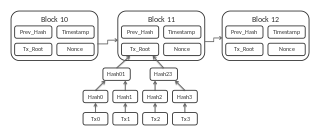 W
WA blockchain, originally block chain, is a growing list of records, called blocks, that are linked using cryptography. Each block contains a cryptographic hash of the previous block, a timestamp, and transaction data.
 W
WBusiness & Information Systems Engineering (BISE) is an international scholarly and double-blind reviewed journal which publishes scientific research on the effective and efficient design and utilization of information systems by individuals, groups, enterprises, and society for the improvement of social welfare. Information systems are understood as socio-technical systems comprising tasks, people, and information technology. Research published in the journal examines relevant problems in the analysis, design, implementation and management of information systems and covers areas of information management, computer science, business administration and economics, new media, and operations research. BISE publishes bimonthly, and features a double-blind peer review process.
 W
WCarWings, renamed NissanConnect in 2015, and also branded as Infiniti InTouch is a vehicle telematics service offered by the Nissan Motor Company to drivers in Japan, the United States, Canada, Great Britain, and most other countries where the LEAF is sold. It provides mobile connectivity for on-demand traffic information services and internet provided maps displayed inside select Nissan vehicles. The service began in December 1997, having been installed in the 1997 Nissan Cedric, Nissan Gloria, Nissan President, Nissan Cima and the Nissan Elgrand.
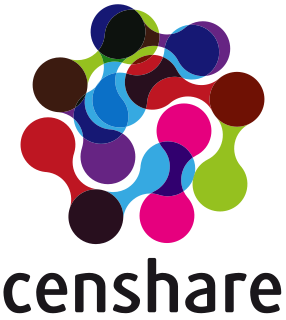 W
Wcenshare is a commercial Digital Experience Platform in the form of an Enterprise Content Management System (ECMS) by the German software manufacturer censhare AG. It integrates all of the entered media information in a single system, organizes content and automates the respective processes. The platform integrates the applications Collaboration and Process Management, Digital Asset Management, Product Information Management, Omnichannel Content Management, Brand Management and Marketing Resource Management. censhare is an Editorial System as well as a Web Content Management System. It can be used for cross-media publishing of content in different media such as Multi Format Publishing, Cross-Media Publishing and Multi Channel Publishing. The system is used in media houses and other companies and institutions for the generation and output of content in conventional, standard communication media, as well as for corporate communication, marketing, brand management, multichannel marketing, the processing of sales publications and for collaboration. On a technical level the content, templates, layouts, structures and user accounts are stored and managed separately in a central graph database.
 W
WCIMACT is EUROCONTROL's Civil-Military Air Traffic Management Co-ordination Tool.
 W
WA control-flow diagram (CFD) is a diagram to describe the control flow of a business process, process or review.
 W
WCSPro, short for the Census and Survey Processing System, is a public domain data processing software package developed by the U.S. Census Bureau and ICF International. Serpro S.A. was involved in past development. Funding for development comes primarily from the U.S. Agency for International Development. The main purpose of this software framework is to design application for data collection and processing.
 W
WDAD-IS is the acronym of the worldwide Domestic Animal Diversity Information System of the Food and Agriculture Organization of the United Nations, within the FAO's management of animal genetic resources programme. It includes a searchable database of information about breeds, the Global Databank for Animal Genetic Resources; it also holds tools for management, and contacts for the National and Regional Coordinators for the programme. Data from the Global Databank is used for reporting on the global status and trends of animal genetic resources. The fourth version of the DAD-IS was launched on 21 November 2017.
 W
WA dashboard is a type of graphical user interface which often provides at-a-glance views of key performance indicators (KPIs) relevant to a particular objective or business process. In other usage, "dashboard" is another name for "progress report" or "report" and considered a form of data visualization.
 W
WA decision support system (DSS) is an information system that supports business or organizational decision-making activities. DSSs serve the management, operations and planning levels of an organization and help people make decisions about problems that may be rapidly changing and not easily specified in advance—i.e. unstructured and semi-structured decision problems. Decision support systems can be either fully computerized or human-powered, or a combination of both.
 W
WDiablo Data Systems was a division of Xerox created by the acquisition of Diablo Systems Inc. for US$29 million in 1972, a company which had been founded in 1969 by George E. Comstock, Charles L. Waggoner and others.
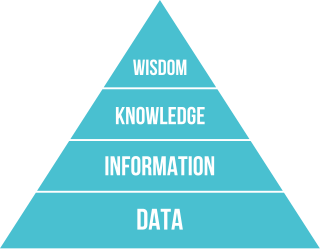 W
WThe DIKW pyramid, also known variously as the DIKW hierarchy, wisdom hierarchy, knowledge hierarchy, information hierarchy, and the data pyramid, refers loosely to a class of models for representing purported structural and/or functional relationships between data, information, knowledge, and wisdom. "Typically information is defined in terms of data, knowledge in terms of information, and wisdom in terms of knowledge".
 W
WIn Japan, the Earthquake Early Warning (EEW) is a warning issued when an earthquake is detected. The warnings are primarily issued by the Japan Meteorological Agency (JMA), with guidance on how to react to them.
 W
WThe German Emigrants Database is a research project on European emigration to the United States of America. It is hosted by the Historisches Museum Bremerhaven. The database contains information about individuals who emigrated during the period of 1820-1939 mainly through German ports towards the United States. The aim of the GED is to make the collected data available to historical and social science research worldwide. Furthermore, the GED enables socio-statistical evaluations of emigrant data. In addition, the GED allows interested people to look for immigrant ancestors. The German Emigrants Database is financed by private donations and income generated by the database. Thus it receives no public subsidy. The revenues will be used entirely for the further expansion of the database. Legal and financial holder of the GED is the charitable “Association of Friends of the Historisches Museum Bremerhaven e.V.”
 W
WThe European Research Center for Information Systems (ERCIS) was founded in 2004 at the University of Münster in Münster, North Rhine-Westphalia, Germany. The objective of ERCIS is connecting research in Information systems with Business, Computer Science, Communication Sciences, Law, Management and Mathematics. The ERCIS consists of leading national and international universities and companies in the field of Information Systems.
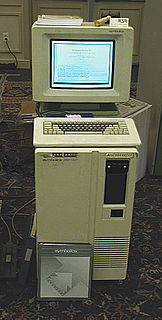 W
WIn artificial intelligence, an expert system is a computer system emulating the decision-making ability of a human expert. Expert systems are designed to solve complex problems by reasoning through bodies of knowledge, represented mainly as if–then rules rather than through conventional procedural code. The first expert systems were created in the 1970s and then proliferated in the 1980s. Expert systems were among the first truly successful forms of artificial intelligence (AI) software. An expert system is divided into two subsystems: the inference engine and the knowledge base. The knowledge base represents facts and rules. The inference engine applies the rules to the known facts to deduce new facts. Inference engines can also include explanation and debugging abilities.
 W
WG-Book is a telematics subscription service provided by Toyota Motor Corporation in Japan for its Toyota- and Lexus-branded vehicles. G-Book allows users to link with cellphones. personal digital assistants (PDA)'s, personal computers (PC) and G-Book equipped cars across Japan. It is based on the former GAZOO infrastructure of Toyota's membership-based information service and membership system, and it provides interactive information services via vehicle installed touch-screen wireless communication terminals. It also incorporates information from Toyota Mapmaster Inc. which updates digital mapping information and is used by various international companies.
 W
WInformation culture is closely linked with Information Technology, Information Systems and the digital world. It is difficult to give one definition of Information Culture and many approaches exist.
 W
WAn information silo, or a group of such silos, is an insular management system in which one information system or subsystem is incapable of reciprocal operation with others that are, or should be, related. Thus information is not adequately shared but rather remains sequestered within each system or subsystem, figuratively trapped within a container like grain is trapped within a silo: there may be much of it, and it may be stacked quite high and freely available within those limits, but it has no effect outside those limits. Such data silos are proving to be an obstacle for businesses wishing to use data mining to make productive use of their data.
 W
WInformation Systems Journal is a bimonthly peer-reviewed scientific journal that covers all aspects of information systems, with particular emphasis on the relationship between information systems and people, business, and organisations. The journal was established in 1991 as Journal of Information Systems with David Avison and Guy Fitzgerald as founding editors-in-chief. It obtained its current name in 1994. The current editor-in-chief is Robert M Davison.
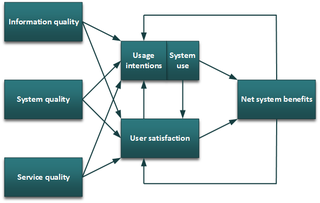 W
WThe information systems success model is an information systems (IS) theory which seeks to provide a comprehensive understanding of IS success by identifying, describing, and explaining the relationships among six of the most critical dimensions of success along which information systems are commonly evaluated. Initial development of the theory was undertaken by William H. DeLone and Ephraim R. McLean in 1992, and was further refined by the original authors a decade later in response to feedback received from other scholars working in the area. The IS success model has been cited in thousands of scientific papers, and is considered to be one of the most influential theories in contemporary information systems research.
 W
WInternavi is a vehicle telematics service offered by the Honda Motor Company to drivers in Japan. In the United States, the service is known as HondaLink, or sometimes MyLink. It provides mobile connectivity for on-demand traffic information services and internet provided maps displayed inside selected Honda vehicles. The service began August 1997 and was first offered in the 1998 Honda Accord and the Honda Torneo sold only in Japan starting July 1998. The service received a revision to services offered October 2002, adding traffic information delivery capabilities for subscribers to the Internavi Premium Club, and was optional on most Honda vehicles sold in Japan. VICS was integrated into the service starting September 2003. Membership in the service has steadily grown to exceed 5 million subscribers as of March 2007.
 W
WThe issue-based information system (IBIS) is an argumentation-based approach to clarifying wicked problems—complex, ill-defined problems that involve multiple stakeholders. Diagrammatic visualization using IBIS notation is often called issue mapping.
 W
WThe Journal of Strategic Information Systems is a quarterly peer-reviewed academic journal covering management, business, and organizational issues associated with the use of information systems. It was established in December 1991 and is published by Elsevier. The editor-in-chief is Guy Gable.
 W
WKarTrak, sometimes KarTrak ACI (for Automatic Car Identification) is a colored bar code system designed to automatically identify rail cars and other rolling stock. KarTrak was made a requirement in North America, but technical problems led to abandonment of the system in the late 1970s.
 W
WLabLynx, Inc. is a privately owned, funded, and managed American corporation that develops, supports, and markets laboratory information management system (LIMS) solutions. Its primary offerings over the years have included ELab, webLIMS, and their successor, LabLynx LIMS. The company’s primary clients include laboratories in the agriculture, clinical, environmental, forensics, health care, and manufacturing industries, including government agencies. The company is known for introducing one of the first browser-based LIMS products in 1997 and being in the laboratory informatics industry for decades.
 W
WA laboratory information management system (LIMS), sometimes referred to as a laboratory information system (LIS) or laboratory management system (LMS), is a software-based solution with features that support a modern laboratory's operations. Key features include—but are not limited to—workflow and data tracking support, flexible architecture, and data exchange interfaces, which fully "support its use in regulated environments". The features and uses of a LIMS have evolved over the years from simple sample tracking to an enterprise resource planning tool that manages multiple aspects of laboratory informatics.
 W
WMEVA International is a private Iranian company that supplies PC accessories to the international market.
 W
WMultiple-criteria decision-making (MCDM) or multiple-criteria decision analysis (MCDA) is a sub-discipline of operations research that explicitly evaluates multiple conflicting criteria in decision making. Conflicting criteria are typical in evaluating options: cost or price is usually one of the main criteria, and some measure of quality is typically another criterion, easily in conflict with the cost. In purchasing a car, cost, comfort, safety, and fuel economy may be some of the main criteria we consider – it is unusual that the cheapest car is the most comfortable and the safest one. In portfolio management, managers are interested in getting high returns while simultaneously reducing risks; however, the stocks that have the potential of bringing high returns typically carry high risk of losing money. In a service industry, customer satisfaction and the cost of providing service are fundamental conflicting criteria.
 W
WA Notification LED is a small RGB or monochrome LED light usually present on the front-facing screen bezel of smartphones and feature phones whose purpose is to blink or pulse to notify the phone user of missed calls, incoming SMS messages, notifications from other messaging apps etc. It usually pulses in a continuous way to draw the attention of the user. It is a part of the device's notification system that uses a cloud-powered push notification service to relay remote notification messages to the user, or local notifications. Similar to audio notifications, a notification LED is a very battery-efficient way to inform the user of new notifications without turning on the screen at all.
 W
WThe Ocean Biodiversity Information System (OBIS), formerly Ocean Biogeographic Information System, is a web-based access point to information about the distribution and abundance of living species in the ocean. It was developed as the information management component of the ten year Census of Marine Life (CoML) (2001-2010), but is not limited to CoML-derived data, and aims to provide an integrated view of all marine biodiversity data that may be made available to it on an open access basis by respective data custodians. According to its web site as at July 2018, OBIS "is a global open-access data and information clearing-house on marine biodiversity for science, conservation and sustainable development." 8 specific objectives are listed in the OBIS site, of which the leading item is to "Provide [the] world's largest scientific knowledge base on the diversity, distribution and abundance of all marine organisms in an integrated and standardized format".
 W
WIn transportation, the Physical Internet® refers to the combination of digital transportation networks that are deploying to replace analog road networks. As the Internet has resolved itself into niche implementations for high-speed (fiberoptics), local area networks (Wifi), and local device (BlueTooth). ET3 and Hyperloop are currently high speed examples. JPods are examples of urban networks.
 W
WSelf-service is the practice of serving oneself, usually when making purchases. Aside from Automatic Teller Machines, which are not limited to banks, and customer-operated supermarket check-out, labor-saving of which has been described as self-sourcing, there is the latter's subset, selfsourcing and a related pair: End-user development and End-user computing.
 W
WTotal Operations Processing System (TOPS) is a computer system for managing the locomotives and rolling stock owned by or operated on a rail system. It was originally developed by the Southern Pacific Railroad, the Stanford University and IBM and was introduced on the railroad in 1968; despite being widely sold to the United States railroads, the system found greater success in the United Kingdom, where it has been used by British Rail (BR) and its successors.
 W
WThe ucode system is an identification number system that can be used to identify things in the real world uniquely. Digital information can be associated with objects and places, and the associated information can be retrieved by using ucode.